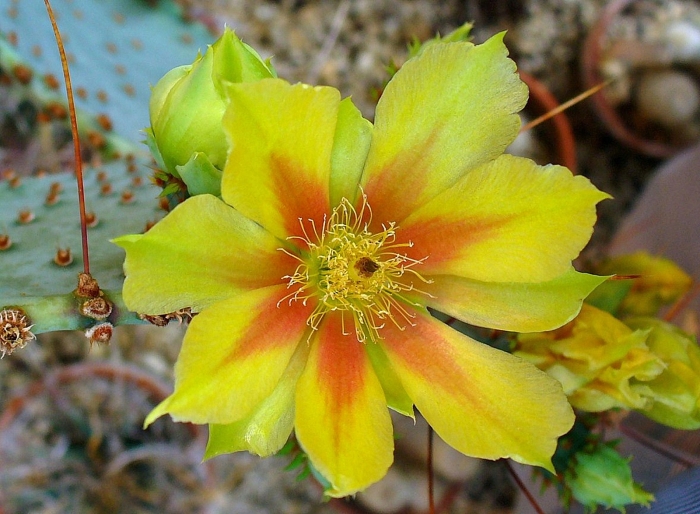Violet Pricklypear
(Opuntia gosseliniana)
Violet Pricklypear (Opuntia gosseliniana)
/
/

H. Zell
CC BY-SA 3.0
Image By:
H. Zell
Recorded By:
Copyright:
CC BY-SA 3.0
Copyright Notice:
Photo by: H. Zell | License Type: CC BY-SA 3.0 | License URL: https://creativecommons.org/licenses/by-sa/4.0 | Uploader: Llez | Publisher: Wikimedia Commons |



















































Estimated Native Range
Summary
Opuntia gosseliniana, commonly known as Violet Pricklypear, is an evergreen succulent native to the Sonoran and Mojave Deserts in the Southwestern USA and Northwestern Mexico. It typically grows to a height of 6-8 feet (1.8-2.4 meters) and a width of 8-10 feet (2.4-3 meters). This cactus has a distinctive appearance with its flat, fleshy, bluish-purple pads and can form dense, shrubby clumps. It blooms with yellow flowers primarily in the spring and early summer, which are followed by reddish-purple fruits that are both showy and edible. The flowers are diurnal, closing at night and reopening in the morning.
Violet Pricklypear is valued for its drought tolerance and unique coloration, making it a striking addition to xeriscapes, rock gardens, and desert-themed landscapes. It is also used as a barrier plant due to its spiny nature. In cultivation, it requires minimal maintenance, thriving in full sun or part shade with very low water needs once established. It prefers well-draining soils, and overwatering should be avoided to prevent root rot. While generally pest-resistant, it can be susceptible to cochineal scale insects. Gardeners should handle this plant with care due to its sharp spines.CC BY-SA 4.0
Violet Pricklypear is valued for its drought tolerance and unique coloration, making it a striking addition to xeriscapes, rock gardens, and desert-themed landscapes. It is also used as a barrier plant due to its spiny nature. In cultivation, it requires minimal maintenance, thriving in full sun or part shade with very low water needs once established. It prefers well-draining soils, and overwatering should be avoided to prevent root rot. While generally pest-resistant, it can be susceptible to cochineal scale insects. Gardeners should handle this plant with care due to its sharp spines.CC BY-SA 4.0
Plant Description
- Plant Type: Succulent
- Height: 6-8 feet
- Width: 8-10 feet
- Growth Rate: Moderate
- Flower Color: Yellow
- Flowering Season: Spring, Summer
- Leaf Retention: Evergreen
Growth Requirements
- Sun: Full Sun, Part Shade
- Water: Very Low, Low
- Drainage: Medium, Fast
Common Uses
Bee Garden, Bird Garden, Butterfly Garden, Deer Resistant, Drought Tolerant, Fire Resistant, Hummingbird Garden, Low Maintenance, Rock Garden, Street Planting
Natural Habitat
Native to the Sonoran and Mojave Deserts
Other Names
Common Names: Purple Prickly Pear
Scientific Names: , Opuntia gosseliniana, Opuntia santa-rita, Opuntia chlorotica var. santa-rita, Opuntia violacea var. santa-rita, Opuntia violacea var. gosseliniana, Opuntia macrocentra var. santa-rita, Opuntia gosseliniana var. santa-rita, Opuntia chlorocentra var. santa-rita, Opuntia chlorotica var. gosseliniana
GBIF Accepted Name: Opuntia gosseliniana F.A.C.Weber